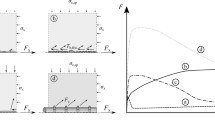Abstract
An experimental study of the bond between ultra-high-performance steel-fibre reinforced concrete (UHPSFRC) cast upon glass-fibre reinforced polymer (GFRP) sheets, as well as of the bond between epoxy-jointed precast UHPSFRC sheets, has been conducted at Chalmers University of Technology. Both shear and tension tests have been performed. Several surface treatments of the different interfaces have been tested. For the joint interface between UHPSFRC and GFRP the best performance was found for a surface with double-bent steel fibres added to epoxy overspread with sand coating, which were allowed to harden prior to casting the concrete. For the epoxy-jointed concrete sheets the best performance was found for a surface where the smooth ‘formwork side’ was sand-blasted before the epoxy gluing. However, it was concluded that more testing is needed before decisive recommendations can be made. In addition, materials tests of the UHPSFRC have been conducted in both tension and compression.









Similar content being viewed by others
References
Harryson P (2002) Industrial bridge construction—merging developments of process, productivity and products with technical solutions. Department of Structural Engineering, Concrete Structures, Chalmers University of Technology, Licentiate Thesis, Publication 02:1, Göteborg, 104 pp
Harryson P (2007) Experimentell studie av vidhäftning mellan högpresterande stålfiberarmerad betong gjuten på glasfiberarmerade polymerskivor samt av epoxifog mellan betongskivor (in Swedish “experimental study of bond between high performance steel fibre reinforced concrete cast upon glass fibre reinforced polymers sheets and of epoxy jointed concrete sheets”). Department of Civil and Environmental Engineering, Structural Engineering, Concrete Structures, Chalmers University of Technology, Report 2007:23, Göteborg, 135 pp
Harryson P (2008) The i-bridge, a novel bridge concept, feasibility studies embracing industrial bridge engineering, 19 pp (to be published)
Harryson P (2009) Laboratory test and finite element analyses of a prototype bridge beam. Nordic Concrete Research, Publication No. 39, 2009/1, pp 89–104
Nielsen CV (1995) Ultra high-strength steel fibre reinforced concrete, Part I: basic strength properties of compresit matrix. Department of Structural Engineering, Technical University of Denmark, Report No 323, Serie R, Copenhagen, 188 pp
Nielsen CV (1995) Ultra high-strength steel fibre reinforced concrete, Part II: structural applications of compresit. Department of Structural Engineering, Technical University of Denmark, Report No 324, Serie R, Copenhagen, 154 pp
Gustavsson K (1981) Joints in composite concrete structures with thin overlay (in Swedish). Department of Structural Engineering, Concrete Structures, Chalmers University of Technology, Report 81:7, Göteborg, 110 pp
Carlswärd J (2006) Shrinkage cracking of steel fibre reinforced self compacting overlays. Department of Civil and Environmental Engineering, Division of Structural Engineering, Luleå University of Technology, PhD Thesis, 2006:55, Luleå, 250 pp
Jonasson J-E (1977) Computer programs for non-linear analyses of concrete in view of shrinkage, creep and temperature (in Swedish). CBI Research Report 7:77, Swedish Cement and Concrete Institute, Stockholm
Magnusson J (2000) Bond and anchorage of ribbed bars in high-strength concrete. Department of Structural Engineering, Concrete Structures, Chalmers University of Technology, Ph.D. Thesis. Publication 00:1, Göteborg, 315 pp
Walter R (2005) Cement-based overlay for orthotropic steel bridge decks, a multi-scale modeling approach. Department of Civil Engineering, Technical University of Denmark, Ph.D. Thesis, Lyngby, 225 pp
Löfgren I (2005) Fibre-reinforced concrete for industrial construction—a fracture mechanics approach to material testing and structural analysis. Department of Civil and Environmental Engineering, Structural Engineering, Chalmers University of Technology, Ph.D. Thesis, Publication 2378, Göteborg, 260 pp
CEB (1993) CEB-FIP model code 1990. CEB Bulletin d’Information No. 213/214, Lausanne, 437 pp
Eurocode EC2 (2001) ENV 1992-1-1: design of concrete structures, Part 1: general rules and rules for buildings. European Committee for Standardization, Brussels
ACI 318 (1999) Building code requirements for structural concrete. American Concrete Institute, Michigan, 391 pp
BBK04 (2004) Boverkets handbook on concrete structures (in Swedish). Boverket, Karlskrona, 271 pp
Nielsen MP (1984) Limit analysis and concrete plasticity. Prentice-Hall, New Jersey, 420 pp
Reinhardt HW (1989) Fracture mechanics of concrete structures—from theory to applications. Chapter 16: joints. In: Elfgren L (ed) RILEM, Report of Technical Committee 90-FMA Fracture Mechanics to Concrete—Applications. Chapman and Hall, London, pp 363–368
Eurocomp (1996) Structural design of polymer composites, EUROCOMP design code and handbook. In: Clarke E (ed) The European structural polymeric composites group. FN Spon, Chapman & Hall, London, 751 pp
Myers J, Jeffries J, Shan X (2007) Effect of varied surface roughness and concrete strength on the bond performance of FRP fabrics. In: Darby AP, Ibell TJ (eds) Advanced composites for construction. Proceedings of ACIC 07. University of Bath, Bath, pp 232–242
Carolin A (2003) Carbon fibre reinforced polymers for strengthening of structural elements. Department of Civil and Mining Engineering, Division of Structural Engineering, Luleå University of Technology, PhD Thesis, 2003:18, Luleå, 205 pp
Jia J, Boothby T, Bakis C (2004) Durability of GFRP-concrete bonded interfaces. In: Proceedings from metropolitan habitats and infrastructure, IABSE symposium, Shanghai, 6 pp
Täljsten B (2002) FRP strengthening of existing concrete structures, design guidelines. Department of Civil Engineering, Division of Structural Engineering, Luleå University of Technology, Luleå, 228 pp
Schaumann E, Vallée T, Keller T (2006) A new concepts for a lightweight hybrid-FRP bridge deck. In: Proceedings of the 7th international conference on short and medium span bridges, Montreal, 8 pp
Acknowledgements
This research has been financially supported by the Swedish Road Administration and the Swedish Agency for Innovation Systems (VINNOVA). The work has been supervised by professor Kent Gylltoft at Chalmers University of Technology.
Author information
Authors and Affiliations
Corresponding author
Rights and permissions
About this article
Cite this article
Harryson, P. Bond between fibre reinforced concrete and fibre reinforced polymers. Mater Struct 44, 377–389 (2011). https://doi.org/10.1617/s11527-010-9633-5
Received:
Accepted:
Published:
Issue Date:
DOI: https://doi.org/10.1617/s11527-010-9633-5




